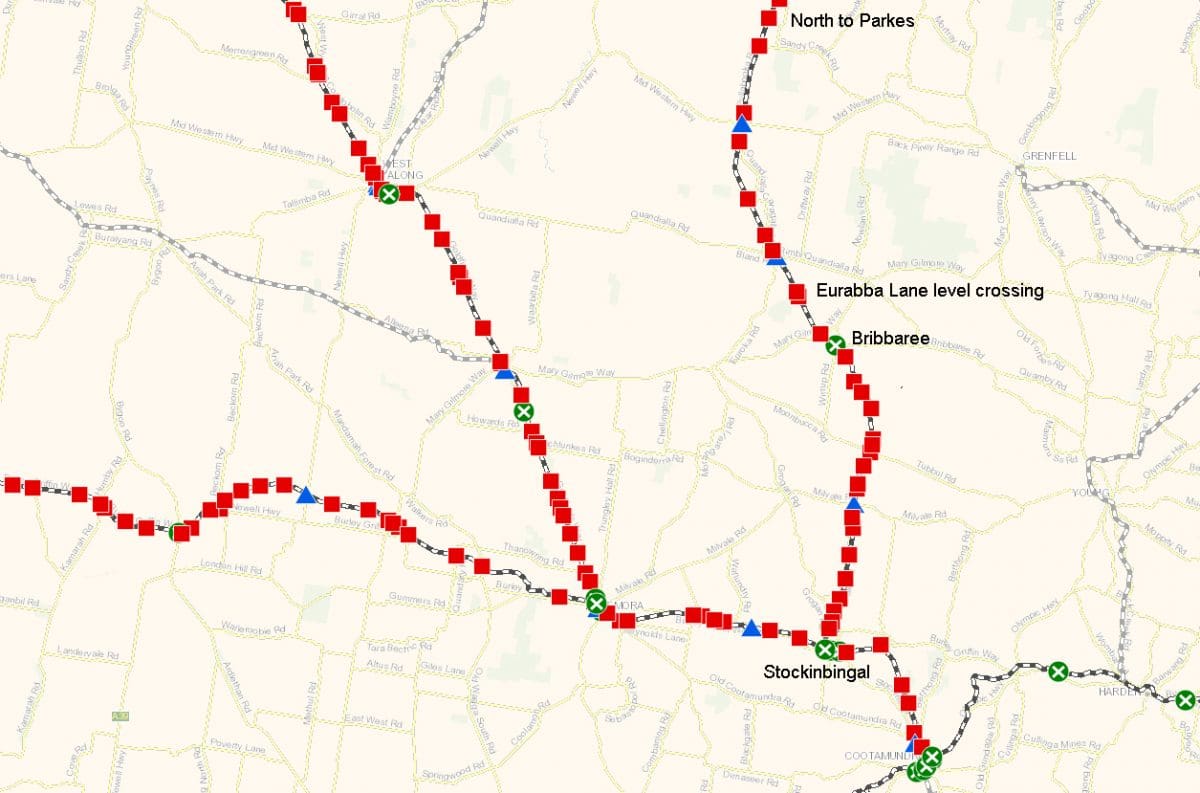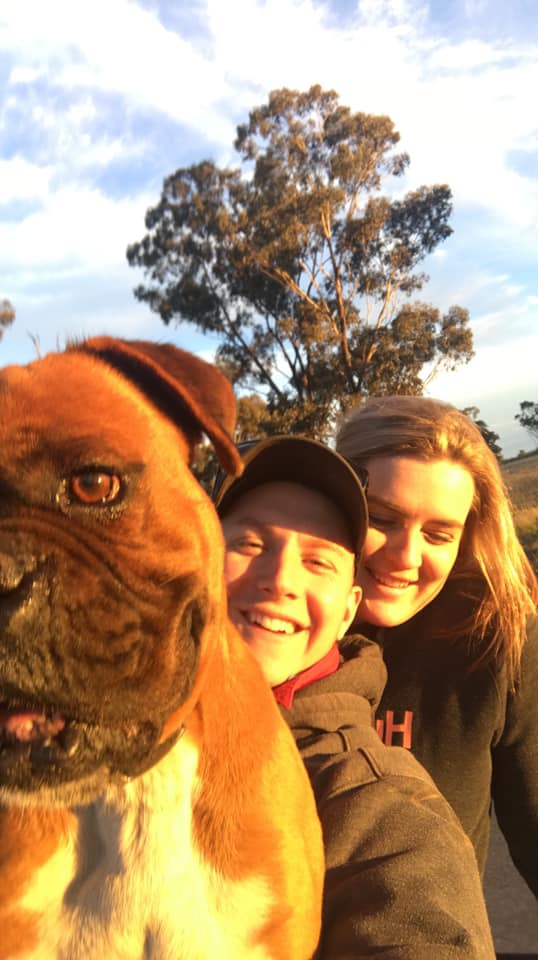
The Inland Rail route includes the Stockinbingal to Parkes section, which alone has more than 40 passive level crossings as marked by red squares. Active crossings are marked with blue triangles for flashing lights, and green circles indicate boom gates with flashing lights. Source: Transport for NSW with site names in large type overlaid by Grain Central.
A CAMPAIGN to make level crossings safer has been mounted in New South Wales following a double fatality in the Bribbaree district near Young.
Driving the campaign is Maddie Bott, whose fiancé Ethan Hunter and his colleague Mark Fenton were travelling in a truck carrying gypsum which collided with a moving freight train as it crossed south of Eurabba Lane on February 23.
The site is one of more than 40 passive crossings on the Stockinbingal to Parkes line (S2P), recently upgraded as part of the Inland Rail project which will provide a freight link between Brisbane and Melbourne.
Inland Rail will see train frequency increase on the line, and Ms Bott said it will also increase the risk of collisions at passive crossings marked to motorists only with stop or give-way signs.
Call for lights
In her Improving safety at level crossings e-petition on the Parliament of NSW website, Ms Bott said the crossing where Mr Hunter and Mr Fenton died had only a stop sign to mark it.
“Visibility at this crossing was affected by many factors including overgrown grass, trees blocking the view, and the road they approached the crossing from is not at 90 degrees to the track,” she stated.
“Had this crossing had lights, these factors would have been irrelevant as they would (have) been notified of the oncoming train and would not (have) proceeded to cross the railway track.”
The e-petition calls for the NSW Legislative Assembly to:
- Make warning lights mandatory at all level crossings;
- Decrease speed limits on highways for vehicles approaching level crossings; and,
- Make trains more visible with reflective material and better lights.
The e-petition yesterday hit the 20,000 signatures from NSW residents needed to enable it to be tabled and debated in the NSW Parliament, and two weeks ahead of deadline.
NSW has more than 3800 level crossings, and more than 1400 are on public roads.
Ms Bott said only 30 per cent of those have active warning controls.
Support from MP
The accident occurred in the Cootamundra electorate, and its Member of Parliament Steph Cooke has met with Ms Bott and senior members of the NSW Government for preliminary discussions about improving safety at level crossings.

Ethan Hunter and his fiancee Maddie Bott with their dog Knox. Ethan died in February in a level-crossing accident not far from his home in Grenfell. Photo: Maddie Bott, Facebook
“We owe it to her and all those who have lost loved ones in rail-crossing accidents to fight for improved safety,” Ms Cooke said in a statement.
S2P is now one of 13 sections in the Australian Rail Track Corporation’s (ARTC) Inland Rail project.
It has seen several level-crossing accidents since 2000.
Two passive level-crossing fatalities occurred between Forbes and Wirrinya, the first in May 2005 when the driver of a Landcruiser died at Grawlin, and the second in March 2007, when a truck driver died at Back Creek.
In February 2020, and only two crossings south of Eurabba Lane, a truck hit a train at Bribbaree, and the truck driver escaped with minor injuries.
Improvements north of Parkes
North of S2P is the Parkes to Narromine section, and ARTC has said it has improved safety at about 30 level crossings on the upgraded stretch which was commissioned last year.
In late April, the NSW Government reduced speed limits from 100 kilometres per hour to 80km/h on the approach to active level crossings along the Inland Rail route in Parkes and Narromine to improve safety for motorists.
“Crashes at level crossings have the potential to cause multiple fatalities and have devastating impacts on families and local communities,” Minister for Regional Transport and Roads Paul Toole said.
“From 2001 to 2020, there were 154 crashes between trains and vehicles at level crossings in NSW which resulted in 14 fatalities and 24 serious injuries.
“More than 30pc of these crashes occurred at locations where the speed limit was 100km/h or greater.”
In September 2015 in Narromine, a truck and train collided on an active crossing, and the truck driver died.
The most recent level-crossing accident in NSW occurred yesterday afternoon south of Dungog, and three occupants of the passenger vehicle involved have been hospitalised.
Shared pathways
Level crossing accidents occur in agricultural areas across Australia.
In South Australia last year, a vehicle driver and passenger died in an incident at Mallala in February, and a driver, the sole occupant, died in April at Culburra.
At Vite Vite in south-west Victoria, a collision last month injured the driver and passenger in a truck as well as the train driver.
Train crew members rarely die in level crossing accidents, but can bear the trauma of being involved in collisions they are often powerless to avoid.
They are also sometimes alarmed by the near misses they have with vehicles which fail to stop at level crossings.
Reasons for that can be many, and include misjudgement about stopping distance required, fatigue, or reduced visibility caused by obstructions, glare or adverse weather.
“At night and in fog, the risk is through the roof,” one source in the rail industry said.
Four years later, an overbridge dubbed the Five Mates Crossing was built.
Grain Central: Get our free cropping news straight to your inbox – Click here

The vexatious matter of smashes at level crossings reveals a failure to go to a)Root cause(s), and b) Address how ingenuity rather than vast sums of money can solve the problem. Amalgamating a) and b), and looking first at active warning systems, we need to note: The standard flashing lights deliver RED ONLY: this is a problem for 6pc of the male population who have red/green colour-blindness. Incorporating amber in addition is needed.
Warning for road drivers is still needed AHEAD of the crossing. At Longford in Tasmania in the 1950s, yellow flashing lights were installed about 100 metres away from the tracks on both sides to give advance warning. The explanation for this unique installation is somewhat bizarre: a “loop” road was used at weekends as a racing circuit, and the TGR engine drivers demanded greater protection!
The real issue is: How can passive protection be cheaply augmented? For timely answers, we go back 85 years to the Great Plains of the US. It was the dawn of the “streamline era”, and trains were moving at high speed, often in excess of 100mph, over thousands of “grade crossings”. All of these locos were equipped with “Lazy-8” Mars Lights which, beamed their amber flash every few seconds to either side, giving motorists some degree of advance warning. The XPTs have a less-effective Oscillator System: other locos are not so equipped.
The real solution is to set up paired, angled stainless steel mirrors on a single pole, which reflect a targeted laser beam towards the approaching motorist. Amber would be used. It would be the duty of the loco driver to direct it, this being facilitated by micro-computer drawing on programmed memory of the unique geometry of the crossing, and progressing the angle to keep it on target for curved track. The cost of the mirror staunchions would be a small fraction of the standard automated flashing lights.
Another approach, simpler and even cheaper, which may well result in dramatic reduction of accidents, would be to install on all locos, horns with multiple frequencies. This eliminates the possibilty of the loco [monotone] horn harmonising with engine noise in the car, truck or bus. It seems to be overlooked that today’s faster moving and larger road vehicles tend to be air-conditioned and are, in effect, mobile sound lounges.
Clearly, the challenge is to get ingenuity to work, and rely less on the motorist having to do all of the precautionary “effort”, and give the necessary assistance, especially in adverse weather conditions. The suggestions of all inventive types out there should be actively sought!
I can understand the suffering and heartache when a loved one is lost in a level crossing accident but it seems that it is always the train”s fault, not the motorist. If motorists obeyed stop signs at level crossing then there would be very few collisions with trains.
Mention is made of the 2001 Gerogery level crossing collision where 5 people were killed. But no mention is made of the fact that they were racing the train. The replacement overbridge should have been named after the traumatised train driver, not after the ‘five mates’.
The call for every level crossing to be equipped with flashing lights is unrealistic. The cost just could be justified.
John Hoyle,Features Editor,Railway Digest Magazine.